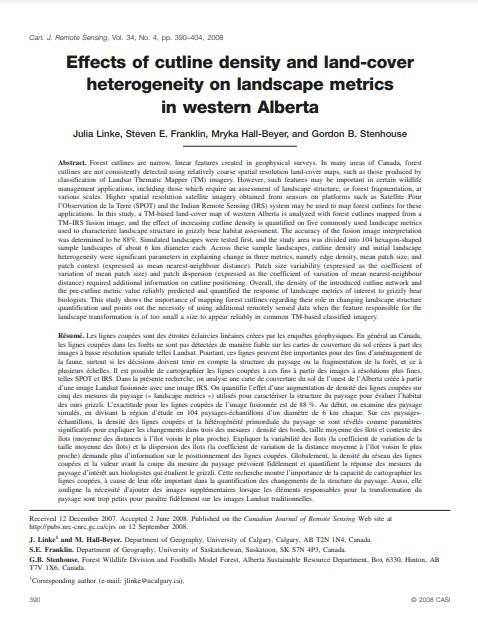Effects of cutline density and land-cover heterogeneity on landscape metrics in western Alberta
Bosque Modelo:
Foothills
Temática:
Gestión forestal
Tipo de documento:
Artículo científico
Resumen
Forest cutlines are narrow, linear features created in geophysical surveys. In many areas of Canada, forest cutlines are not consistently detected using relatively coarse spatial resolution land-cover maps, such as those produced by classification of Landsat Thematic Mapper (TM) imagery. However, such features may be important in certain wildlife management applications, including those which require an assessment of landscape structure, or forest fragmentation, at various scales. Higher spatial resolution satellite imagery obtained from sensors on platforms such as Satellite Pour l’Observation de la Terre (SPOT) and the Indian Remote Sensing (IRS) system may be used to map forest cutlines for these applications. In this study, a TM-based land-cover map of western Alberta is analyzed with forest cutlines mapped from a TM–IRS fusion image, and the effect of increasing cutline density is quantified on five commonly used landscape metrics used to characterize landscape structure in grizzly bear habitat assessment. The accuracy of the fusion image interpretation was determined to be 88%. Simulated landscapes were tested first, and the study area was divided into 104 hexagon-shaped sample landscapes of about 6 km diameter each. Across these sample landscapes, cutline density and initial landscape heterogeneity were significant parameters in explaining change in three metrics, namely edge density, mean patch size, and patch context (expressed as mean nearest-neighbour distance). Patch size variability (expressed as the coefficient of variation of mean patch size) and patch dispersion (expressed as the coefficient of variation of mean nearest-neighbour distance) required additional information on cutline positioning. Overall, the density of the introduced cutline network and the pre-cutline metric value reliably predicted and quantified the response of landscape metrics of interest to grizzly bear biologists. This study shows the importance of mapping forest cutlines regarding their role in changing landscape structure quantification and points out the necessity of using additional remotely sensed data when the feature responsible for the landscape transformation is of too small a size to appear reliably in common TM-based classified imagery.
Información Bibliográfica
Autor:
Linke, J, SE Franklin, M Hall-Beyer and GB Stenhouse, GB.
Revista:
Canadian Journal of Remote Sensing
Año:
2008
N°:
4
País :
Canadá
Páginas:
390 - 404
Volumen:
34
Idioma:
Ingles
Palabras claves
Model forest, Adaptatation, Canada





